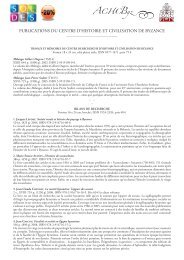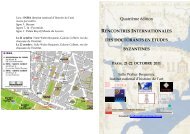booklet of abstracts - Oxford University Byzantine Society
booklet of abstracts - Oxford University Byzantine Society
booklet of abstracts - Oxford University Byzantine Society
You also want an ePaper? Increase the reach of your titles
YUMPU automatically turns print PDFs into web optimized ePapers that Google loves.
Session five9:45 | Saturday 5 March 2011 | Lecture TheatreChairPrerona Prasadkeble CollegeThe movements <strong>of</strong> manuscriptsbetween Byzantium and theArabic world and the hypothesis<strong>of</strong> the role <strong>of</strong> the Graeco-Arabictranslation movement in therevival <strong>of</strong> literary production inByzantiumJakub Sypiański<strong>University</strong> <strong>of</strong> Paris I–Panthéon-SorbonneBetween the ninth and tenth centuries, interestin Greek manuscripts increased both inByzantium and in Muslim countries. Both phenomenahave much in common, but despitethe geographical proximity, their appearance atalmost the same time is sometimes consideredincidental. Paul Lemerle, author <strong>of</strong> classic studies<strong>of</strong> the Macedonian Renaissance (Le premierhumanisme byzantin) rejects any connectionbetween them. His view has been recentlyreviewed by Dimitri Gutas, a specialist in theGraeco-Arabic translation movement in theAbbasid caliphate. According to him, thesetranslations could have possibly given impetusto the resumption <strong>of</strong> literary production inByzantium after the ‘Dark Ages’. In addition,revived demand in the caliphate for the Greekmanuscripts <strong>of</strong> texts needed for translationactivity could have resumed the activity <strong>of</strong>copying manuscripts in Byzantium.In this light, an almost complete correlationbetween the list <strong>of</strong> works translated intoArabic in Baghdad and a list <strong>of</strong> manuscriptsfirst copied in Byzantium in ninth century, areparticularly interesting. In my paper I intendto focus specifically on one aspect <strong>of</strong> thistheory. I want to explore the <strong>Byzantine</strong> andArab narratives <strong>of</strong> manuscripts deriving fromthe other side <strong>of</strong> the border. Some <strong>of</strong> these storiescan be considered as contrived, thereforein addition to exploring the ways by which themanuscripts moved around, I would like toexamine how we can explain the appearance<strong>of</strong> fictional stories on this topic.Jakub Sypiański’s research interests arethe intellectual relations between Byzantiumand the Arab world until the tenth century. Inbroad terms, they include all areas <strong>of</strong> culturalcontacts between Byzantium, the Arab worldand the Latin West in the middle ages.Psaltika and Asmatika inthe liturgical history <strong>of</strong> the<strong>Byzantine</strong> EmpireOlga GrinchenkoBrasenose College, <strong>Oxford</strong>The <strong>Byzantine</strong> Rite is known for its magnificentservices, beautiful music, and meaningfulpoetry. Despite the large number <strong>of</strong> the liturgicalmanuscripts which have come down tous, the history <strong>of</strong> the <strong>Byzantine</strong> <strong>of</strong>fice is yetto be written. My paper will be dealing witha particular type <strong>of</strong> the <strong>Byzantine</strong> liturgicalmanuscripts – Asmatika and Psaltika. Theseare collections <strong>of</strong> hymns (mostly kontakia)to be sung by a choir (Asmatika) and a soloist(Psaltika) in the Orthodox Office datingfrom the late tenth to fourteenth centuries.At first glance all manuscripts resemble eachother and have a similar tripartite structure;however, each copy is absolutely unique.In my paper I will provide a comparativeanalysis <strong>of</strong> the content <strong>of</strong> the manuscripts,describe their liturgical and calendrical features,and bring attention to the enigmatic16 | Between Constantines





